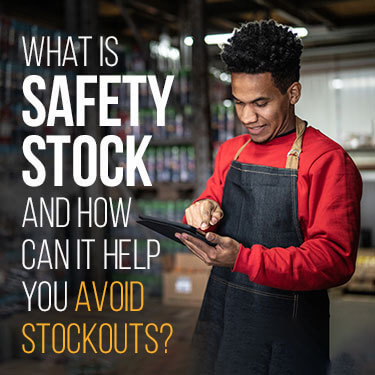
 Copy URL to Clipboard
Copy URL to Clipboard
Safety stock in supply chain can prove to be both a friend and foe to any business. The risks and rewards associated with safety stock can prove chaotic without careful planning and due diligence. So what is safety stock and how can it help your business?
Safety stock in supply chain is used as a preventative measure against stockouts by ensuring that buffer inventory is available. This strategy utilizes variable formulas to predict market fluctuations and lead times through forecasting.
Having low inventory is inevitable, however, this disruption can be avoided. A solid understanding of safety stock and stockouts is vital for any business or supply chain. Our guide below will provide insight into whether or not safety stock is a suitable option for you.
The purpose of safety stock is to maintain inventory levels in the event that a stockout occurs. In the supply chain, the flow of goods is a daily necessity. If a stockout happens at the supply chain level, the adverse effects will roll downhill and affect distribution, warehousing, and consumer fulfillment.
Whether you are a brick-and-mortar or eCommerce business, you deal with physical merchandise sold in two different spaces. Nevertheless, the physical merchandise is produced and shipped in the same manner to consumers worldwide.
Maintaining inventory levels of safety stock is essential when considering customer demand while trying to avoid the potential dilemma of running into a stockout. If a stockout does indeed happen, the loyalty of your customers will fall to the wayside and profits will plummet as they look elsewhere to find the goods they seek.
The potential hazards of supply chain disruption can present themselves at any time. The best practice is to prepare for such eventualities and utilize a buffer stock mentality in your inventory. Supply disruptions can cause many problems for both you and the customer.
Products out of stock, back-ordered, or even removed from the market are genuine possibilities to consider for potential stockouts that result in supply chain disruption. Using a “lean inventory strategy”, at the very least, will help prevent supply chain disruptions by minimizing the risk of larger than desired inventories.
Safety stock is a preventative inventory management practice. The point of safety stock is to hold extra inventory to prevent stockouts from happening. This measure occurs if the consumer demand for a product rises or the supply runs low due to manufacturing difficulties due to a lack of raw materials.
Safety stock serves as a buffer so that stockouts do not occur by enabling you to handle supply and demand. Instead of hanging onto high backup reserves of stored inventory, safety stock is a smaller reserve targeted toward goods with a high turnover rate.
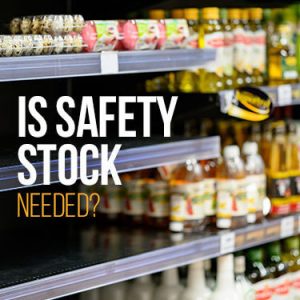
Due to the ever-changing needs of the global economy, nothing is ever certain. Considering issues can occur during manufacturing, shipping, distribution, consumer demand, or during any other point in the supply chain, it’s more important than ever to have preventative measures in place.
Adapting to the changing landscape of supply and demand will keep you in the game without the risk of lost supply, customers, and profit. There are many reasons for implementing a safety stock level strategy in the supply chain.
It is impossible to fully predict consumer demand or supply chain problems when trying to avoid a stockout. These events are inevitable and will happen. The only question is, how can you prepare for such an event?
The choice to fall behind the competition or lead the way is yours to decide. However, determining the safety stock level will give you a practical advantage and greater visibility in terms of market trends, stabilized inventories, and the preparedness to alter your inventory scheme to meet the demands of supply and consumer relationships.
Safety stock inventory presents itself as a backup to a prerendered inventory scheme. The idea is to offer benefits to protect you from stockout situations. When evaluating whether or not to deploy a safety stock strategy, specific considerations are necessary.
Here are some examples of the expected benefits that come from safety stock.
Wherever there is an uncertain supply, keeping extra products on hand is wise to prevent a stockout in inventory. Safety stock in inventory can and will protect you from any manufacturer stockout in your supply chain or protection in the ever-changing and unpredictable consumer market landscape. Safety stock inventory is the ultimate “stop-gap” measure to prevent a stockout from occurring in inventory management.
Reorder points revolve around lead time on goods held inventories and replenishment. A reorder point considers market variables such as historical supply and demand information and any supplier mishaps that have occurred in the past.
With that said, this option of “waiting till the last minute” might not prove a viable notification, especially if the reorder point is low and happens at the wrong time. You cannot always rely on reorder points at specific levels when the stock comes up as low and in need of replenishment. This identifier has the potential of making itself known too late.
Cycle Stock, unlike safety stock, is the current inventory amount and whether or not it is available and ready to meet the average demand during a designated period. In other words, it is when a retailer rotates through an amount of inventory to meet the needs of the sales. A good example is that the available inventory is in the warehouse, storeroom, and store shelves.
Cycle stock opens up more readily available stock by cycling out all inventory while keeping a steady supply moving in. However, with a fast-moving supply, one may consider increasing that supply to give some padding to the available stock by asserting safety stock.
If you ask yourself, “Is safety stock required for my business?” The definitive answer would have to be an emphatic yes. To conduct a reliable business, you need to have a safety stock level, even if minimal.
When fulfilling orders, the time period between when a customer orders a product and receives it is crucial. A fast turnaround time prevents customers from going elsewhere to find what they need while influencing them to shift loyalty to another retailer.
The acronym, SAP, refers to the systems, applications, and products through software deployed to effectively manage the manufacturing, sales, and inventory of a business, warehouse, or supply chain. During the stages of production planning, safety stock can be calculated using the latest in systems and application software.
When calculating safety stock for your supply chain distribution or held inventory, using the latest real-time business software will give you a distinct advantage over the competition. There are many areas where SAP can prove to be a crucial benefit in determining how you as a supply chain or business avoid a stockout through implementing a safety stock.
When considering the most effective way to implement safety stock, material requirements planning (MRP) in SAP is the best solution. In order to meet or exceed consumer demand and fulfillment, the primary function and goal are to meet these expectations ahead or on time.
Some of the benefits that come from an MRP view is a complete overview of the following:
R+L Global Logistics employs the latest supply chain technologies and can offer dependable services to keep the “safety” of your business in mind. These elements encompass the various stages of production, acquisition, and product deployment. This software strategy, of course, all ties into consumer demand and predicts market shifts based on collected data.
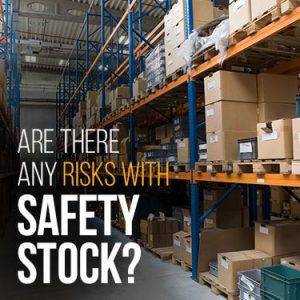
Safety stock does come with risks. Careful calculation must be considered before building a safety stock. By having too much safety stock, you run the risk of high holding costs for your business. Both demand uncertainty and lead time uncertainty can present potential heads up when considering risk.
The inventory storage, obsolescence, and interest expense costs accrue while holding extra inventory. Keeping a limited supply of safety stock is essential so that you do not exceed the available capital to keep your business running smoothly.
There are some negative drawbacks to holding an increased supply. When you have an increased supply, you face the potential of products that expire or spoil while in inventory. Also, there is the possibility of damage impacting your product.
In order to properly evaluate the risks of safety stock, you need to first identify the pros and cons. When you factor in the two, you should have an idea of whether or not safety stock best suits your business.
Ultimately, there are risks associated with keeping a safety stock. However, in any business venture, there is always risk and reward. The key takeaway here is to plan when considering holding safety stock carefully.
Considerable amounts of research, forecasting, capital, and other resources are needed to manage additional stock effectively. However, the long-term payout can become quite substantial if executed correctly.
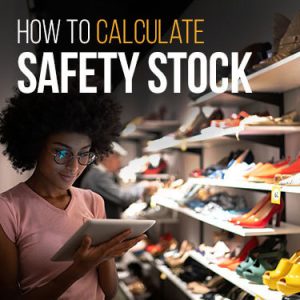
When setting out to perform a safety stock calculation, businesses should begin gathering and researching data related to the stock-keeping units (SKU) that have high turnover rates in their business model.
There is a set of formulas that can be used to calculate safety stock. One formula is known as the “basic safety stock formula,” and the other is the “average max formula.” These two formulas represent the easiest ways to calculate safety stock in supply chain.
The basic safety stock formula is the more traditional form of calculating safety stock. Let's say that we have average daily sales of two hundred units daily for a product, and we want ten days of lead time. We can then calculate average daily sales multiplied by days of lead time which equals the total safety stock.
Formula: (average daily sales x days of lead time) = safety stock
| Average Daily Sales | Days of Lead Time | Total Safety Stock |
| 200 units | 10 days | 2,000 units |
The goal of the average max formula is to calculate the average max number of a product that you may need at any given time. The Average Max formula considers max & average sales and the max & average lead times to calculate the max number of units needed.
The maximum sale is 300 units, and the maximum lead time is 12 days. We then have a maximum of 3,600 units. Our average sales equate to two hundred units then multiplied by an average lead time of ten days. We then subtract the maximum sales by the average sales, which nets us the average maximum number of units we may need at any given time.
Formula: (maximum sale x maximum lead time) - (average sale x average lead time) = average maximum safety stock
| Max Sale x Max Lead | Average Sale x Average Lead | Average Maximum Units |
| 300 units x 12 days | 200 units x 10 days | 1600 units |
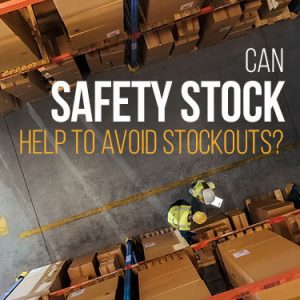
In 2020, a study of stockout monetary losses by Statista for the fiscal year showed a staggering numerical profit loss due to stockouts. Stockouts result in consumers having failed to buy goods or having chosen a competitor in the process. The result is a loss of business that could have potentially been avoided.
The lack of communication between marketing departments and the supply chain resulted in a 40.2 billion dollar loss. There is no doubt that fluctuations in demand can affect a managed inventory. The lack of products on shelves or ready for online fulfillment resulted in losses of around 35.7 billion dollars for the fiscal year.
The net result in retail and eCommerce losses reached an estimated 71.4 billion dollars in total due to stockouts. This number just goes to prove that if carefully calculated safety stock measures had taken place, the total loss this year would have been significantly less.
Why deal with the hassle of managing your inventory anymore? At R+L Global Logistics, our team of experts in distribution and fulfillment services can easily manage your inventories, distribution, and fulfillment.
R+L Global Logistics can remove the stress of warehouse management and freight operations.
Our distribution and fulfillment services offer many reliable and trusted benefits. Our dedicated staff-certified TSA fulfillment centers, and warehouses near major coastal ports and airports have you covered for all of your distribution and fulfillment needs.
R+L Global Logistics is here to support you, any time and anywhere. Feel free to reach out to one of our friendly experts to learn how safety stock can benefit your business. Fill out a quote or call (866) 989-3082.
